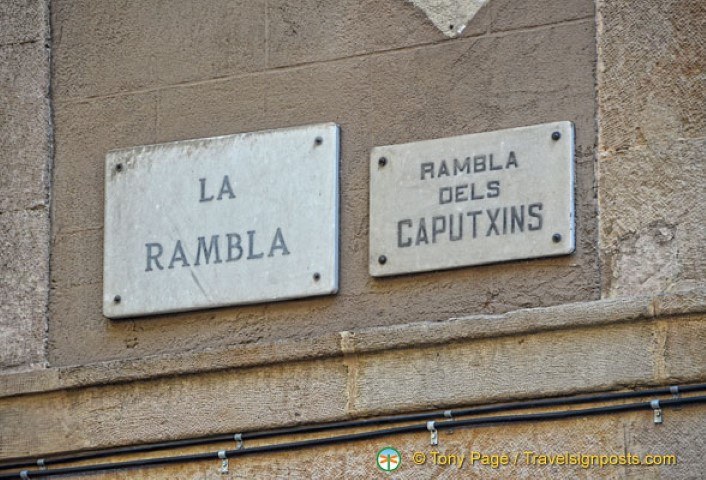We start now the Rambla Caputxins here is very difficult to keep on because it is very crowded. Years ago, people could sit in the chairs that were rented in order to sit there and watch people walk.
We start now the Rambla Caputxins here is very difficult to keep on because it is very crowded. Years ago, people could sit in the chairs that were rented in order to sit there and watch people walk.
This part of the Rambla is called Caputxins because before there was a convent of this religious order placed where now we can find the Plaça Reial. Lot of squares and markets of the Ciutat Vella were born when the old convents were destroyed. How things change! Centuries ago there were lot of religious buildings and now it is full of souvenirs shops.
This part is called officially Rambla dels Caputxins, but before was known as La Rambla de las comedias (Rambla of the Comedies) because it hosted the part from the Principal Theatre until the Grand Theatre of Liceu. Now is known as Middle Rambla because it is the part in the middle and where the street Ferran is, a popular street that leads to the Gothic neighbourhood.
The Gothic is an amazing place where is placed the Cathedral, the old Jewish neighbourhood and the square Sant Jaume, where we can find the council and the Catalan government: La Generalitat de Catalunya.
This part of the rambla was the most important of the Barcelona of the XIX century, where the main shops, hotels and luxury cafés were placed.
The Royal Square is also there, built in 1848. This great square has a fountain called Las Tres Gracias and two lighthouses made by Gaudí. Very close, in the street Nou de la Rambla is placed the Palace Güell, built by the famous modernist architect.
Today, the Royal Square is less majestic than in other times but also very funny because it has restaurant, bars, discos and even a club for pipe smokers.
In the facade of the square is placed the hotel Quatre Nacions, built upon a passage called Bacardí. In the facade was also placed in the XX century the Society for the Foreign, dedicated to promote the tourism. It seems that it was a great idea since Barcelona is nowadays one of the most visited cities in Europe.
From that époque, in which La Rambla was the main shop window of the city, there are still a few establishments left as café de l’Opera, the Hotel Internacional and the popular and old shirt shop Xancó.
It is not rare, then, that in other times, tourists had curiosity for this city. Important persons such as the writer Stendhal or Hans Christian Andersen¸ visited us and mixed among the rich, workers, fishers, soldiers, fruit sellers, newspaper sellers and waiters.
In the Rambla Caputxins… or the Middle…or the Centre… or the Comedies we find the most important piece of the street: the Grand Theatre Liceu, built in the place of other convent, as it couldn’t be otherwise.
In this monumental theatre it is represented the bel canto, or, in other words: opera. This temple of music was inaugurated many years ago, in 1847. It has hosted lots of musical successes of the most famous operas and has suffered several fires and even an attempt. After the last fire which destroyed the theatre completely in 1994 one even more modern and safe building was built preserving the traditional facade. The Liceu also offers us another service, apart from the musical one, it shows us the time because it has a big clock it its upper part. The Ramblas has a lot of contrasts which made it attractive and singular. For instance, we can find the famous opera singer Montserrat Caballé, the universal Catalan, going out of the Liceu surrounded by fans and in front of her, in La Rambla, watch rap musicians dancing at the rhythm of their contemporary music. Hear a frog-puppet performing a waltz by Chopin or enjoy a complete band of Jazz. La Rambla, outside the stage of the Liceu, belongs to the musicians. Musicians who may ask the weather man before performing.
There is another important building apart from the Liceu: the Hotel Oriente which hides an old cloister of the school Sant Bonaventura. This hotel would be the perfect setting for a novel of Agatha Christie.
The Gran Theatre Liceu is delimited by two streets, one more discrete and another with a strong personality. The street Unió, where in the twenties were placed the main offices of several newspapers and the street Sant Pau, which few years ago leaded people to a conflict area with lots of shops and restaurants managed by people of different parts of the world.
If you are also interested in booking tours in and around Barcelona, we recommend Barcelona Day Tours. They offer pickup from your hotel or the port and touring in a small group

